Social Impact: Industrial Revolution on Peasants, Labor, Bourgeoisie
VerifiedAdded on 2023/06/15
|5
|1042
|474
Essay
AI Summary
This essay delves into the Industrial Revolution, focusing on its profound impact on various social classes, including peasants, urban laborers, and the bourgeoisie. It highlights how the Agricultural Revolution paved the way for industrialization by increasing food supply and reducing labor needs. The shift from an agrarian society to a market economy restructured society, increasing material wealth and leading to new philosophies. The essay further explores the changes in work environments, the rise of factories, and the emergence of the bourgeoisie class, alongside the associated social issues like poverty and crime. Ultimately, the Industrial Revolution not only transformed the economic and political landscape but also undermined the existing class structure, leading to a more philosophical and economically driven worldview in the West. Desklib provides access to this essay along with a wide array of study resources including past papers and solved assignments.
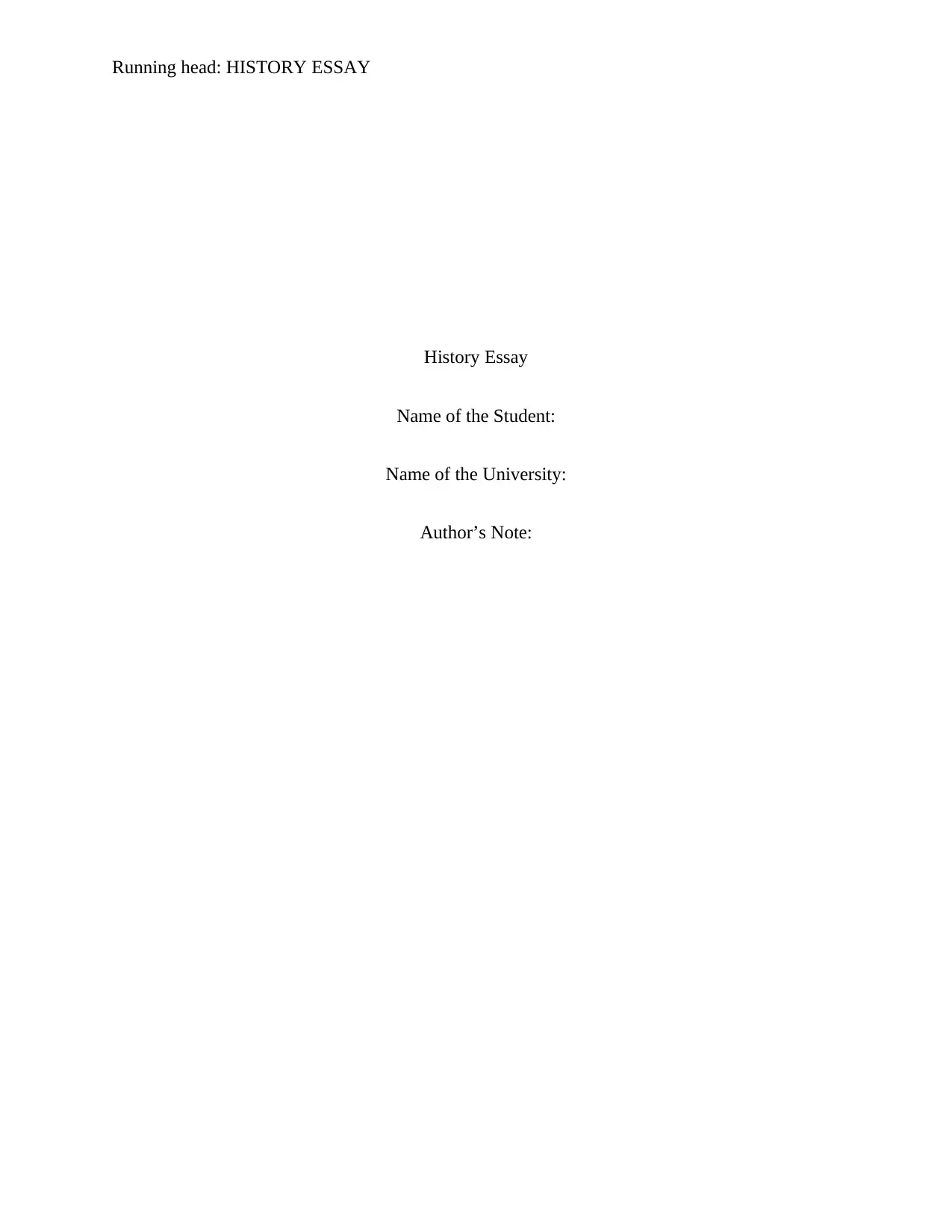
Running head: HISTORY ESSAY
History Essay
Name of the Student:
Name of the University:
Author’s Note:
History Essay
Name of the Student:
Name of the University:
Author’s Note:
Paraphrase This Document
Need a fresh take? Get an instant paraphrase of this document with our AI Paraphraser
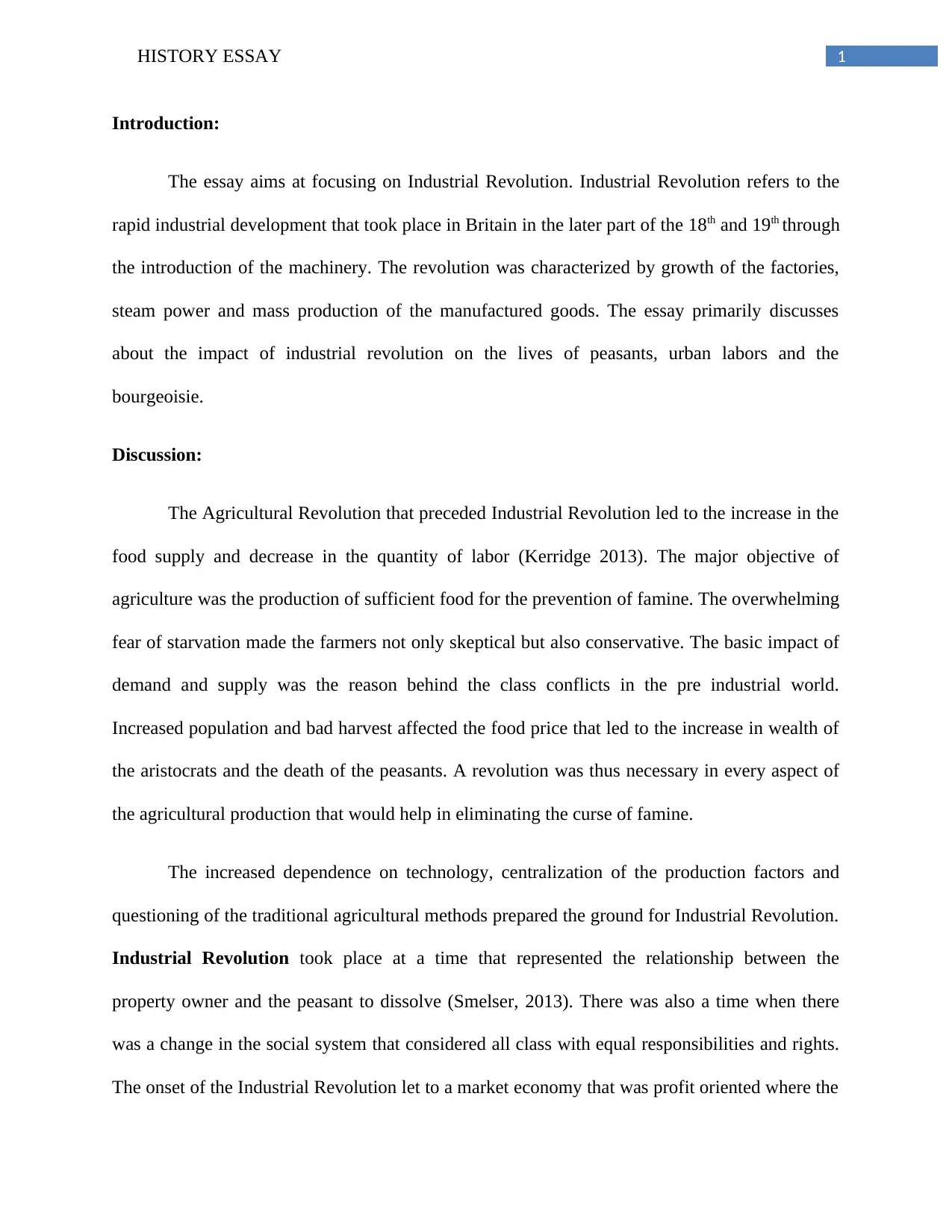
1HISTORY ESSAY
Introduction:
The essay aims at focusing on Industrial Revolution. Industrial Revolution refers to the
rapid industrial development that took place in Britain in the later part of the 18th and 19th through
the introduction of the machinery. The revolution was characterized by growth of the factories,
steam power and mass production of the manufactured goods. The essay primarily discusses
about the impact of industrial revolution on the lives of peasants, urban labors and the
bourgeoisie.
Discussion:
The Agricultural Revolution that preceded Industrial Revolution led to the increase in the
food supply and decrease in the quantity of labor (Kerridge 2013). The major objective of
agriculture was the production of sufficient food for the prevention of famine. The overwhelming
fear of starvation made the farmers not only skeptical but also conservative. The basic impact of
demand and supply was the reason behind the class conflicts in the pre industrial world.
Increased population and bad harvest affected the food price that led to the increase in wealth of
the aristocrats and the death of the peasants. A revolution was thus necessary in every aspect of
the agricultural production that would help in eliminating the curse of famine.
The increased dependence on technology, centralization of the production factors and
questioning of the traditional agricultural methods prepared the ground for Industrial Revolution.
Industrial Revolution took place at a time that represented the relationship between the
property owner and the peasant to dissolve (Smelser, 2013). There was also a time when there
was a change in the social system that considered all class with equal responsibilities and rights.
The onset of the Industrial Revolution let to a market economy that was profit oriented where the
Introduction:
The essay aims at focusing on Industrial Revolution. Industrial Revolution refers to the
rapid industrial development that took place in Britain in the later part of the 18th and 19th through
the introduction of the machinery. The revolution was characterized by growth of the factories,
steam power and mass production of the manufactured goods. The essay primarily discusses
about the impact of industrial revolution on the lives of peasants, urban labors and the
bourgeoisie.
Discussion:
The Agricultural Revolution that preceded Industrial Revolution led to the increase in the
food supply and decrease in the quantity of labor (Kerridge 2013). The major objective of
agriculture was the production of sufficient food for the prevention of famine. The overwhelming
fear of starvation made the farmers not only skeptical but also conservative. The basic impact of
demand and supply was the reason behind the class conflicts in the pre industrial world.
Increased population and bad harvest affected the food price that led to the increase in wealth of
the aristocrats and the death of the peasants. A revolution was thus necessary in every aspect of
the agricultural production that would help in eliminating the curse of famine.
The increased dependence on technology, centralization of the production factors and
questioning of the traditional agricultural methods prepared the ground for Industrial Revolution.
Industrial Revolution took place at a time that represented the relationship between the
property owner and the peasant to dissolve (Smelser, 2013). There was also a time when there
was a change in the social system that considered all class with equal responsibilities and rights.
The onset of the Industrial Revolution let to a market economy that was profit oriented where the
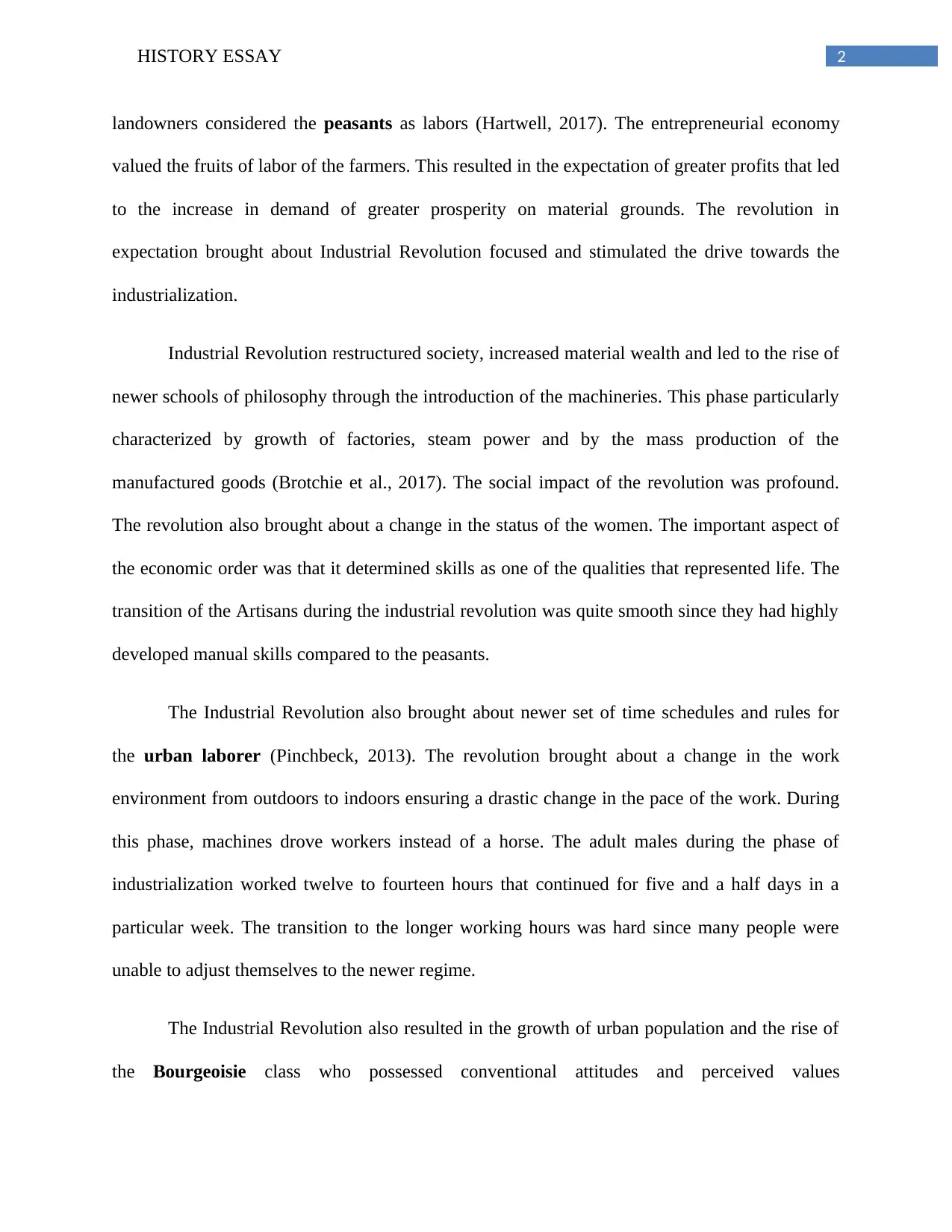
2HISTORY ESSAY
landowners considered the peasants as labors (Hartwell, 2017). The entrepreneurial economy
valued the fruits of labor of the farmers. This resulted in the expectation of greater profits that led
to the increase in demand of greater prosperity on material grounds. The revolution in
expectation brought about Industrial Revolution focused and stimulated the drive towards the
industrialization.
Industrial Revolution restructured society, increased material wealth and led to the rise of
newer schools of philosophy through the introduction of the machineries. This phase particularly
characterized by growth of factories, steam power and by the mass production of the
manufactured goods (Brotchie et al., 2017). The social impact of the revolution was profound.
The revolution also brought about a change in the status of the women. The important aspect of
the economic order was that it determined skills as one of the qualities that represented life. The
transition of the Artisans during the industrial revolution was quite smooth since they had highly
developed manual skills compared to the peasants.
The Industrial Revolution also brought about newer set of time schedules and rules for
the urban laborer (Pinchbeck, 2013). The revolution brought about a change in the work
environment from outdoors to indoors ensuring a drastic change in the pace of the work. During
this phase, machines drove workers instead of a horse. The adult males during the phase of
industrialization worked twelve to fourteen hours that continued for five and a half days in a
particular week. The transition to the longer working hours was hard since many people were
unable to adjust themselves to the newer regime.
The Industrial Revolution also resulted in the growth of urban population and the rise of
the Bourgeoisie class who possessed conventional attitudes and perceived values
landowners considered the peasants as labors (Hartwell, 2017). The entrepreneurial economy
valued the fruits of labor of the farmers. This resulted in the expectation of greater profits that led
to the increase in demand of greater prosperity on material grounds. The revolution in
expectation brought about Industrial Revolution focused and stimulated the drive towards the
industrialization.
Industrial Revolution restructured society, increased material wealth and led to the rise of
newer schools of philosophy through the introduction of the machineries. This phase particularly
characterized by growth of factories, steam power and by the mass production of the
manufactured goods (Brotchie et al., 2017). The social impact of the revolution was profound.
The revolution also brought about a change in the status of the women. The important aspect of
the economic order was that it determined skills as one of the qualities that represented life. The
transition of the Artisans during the industrial revolution was quite smooth since they had highly
developed manual skills compared to the peasants.
The Industrial Revolution also brought about newer set of time schedules and rules for
the urban laborer (Pinchbeck, 2013). The revolution brought about a change in the work
environment from outdoors to indoors ensuring a drastic change in the pace of the work. During
this phase, machines drove workers instead of a horse. The adult males during the phase of
industrialization worked twelve to fourteen hours that continued for five and a half days in a
particular week. The transition to the longer working hours was hard since many people were
unable to adjust themselves to the newer regime.
The Industrial Revolution also resulted in the growth of urban population and the rise of
the Bourgeoisie class who possessed conventional attitudes and perceived values
⊘ This is a preview!⊘
Do you want full access?
Subscribe today to unlock all pages.

Trusted by 1+ million students worldwide
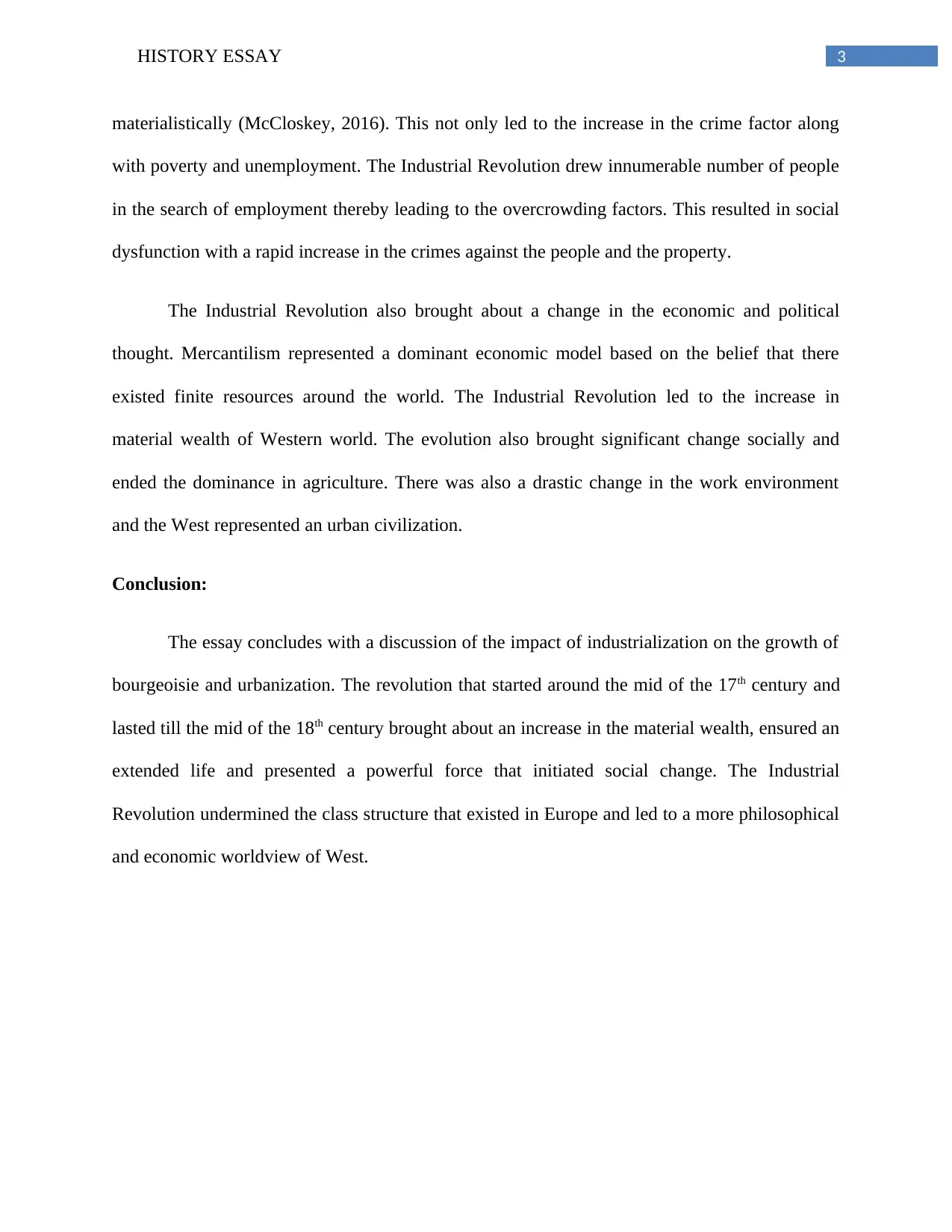
3HISTORY ESSAY
materialistically (McCloskey, 2016). This not only led to the increase in the crime factor along
with poverty and unemployment. The Industrial Revolution drew innumerable number of people
in the search of employment thereby leading to the overcrowding factors. This resulted in social
dysfunction with a rapid increase in the crimes against the people and the property.
The Industrial Revolution also brought about a change in the economic and political
thought. Mercantilism represented a dominant economic model based on the belief that there
existed finite resources around the world. The Industrial Revolution led to the increase in
material wealth of Western world. The evolution also brought significant change socially and
ended the dominance in agriculture. There was also a drastic change in the work environment
and the West represented an urban civilization.
Conclusion:
The essay concludes with a discussion of the impact of industrialization on the growth of
bourgeoisie and urbanization. The revolution that started around the mid of the 17th century and
lasted till the mid of the 18th century brought about an increase in the material wealth, ensured an
extended life and presented a powerful force that initiated social change. The Industrial
Revolution undermined the class structure that existed in Europe and led to a more philosophical
and economic worldview of West.
materialistically (McCloskey, 2016). This not only led to the increase in the crime factor along
with poverty and unemployment. The Industrial Revolution drew innumerable number of people
in the search of employment thereby leading to the overcrowding factors. This resulted in social
dysfunction with a rapid increase in the crimes against the people and the property.
The Industrial Revolution also brought about a change in the economic and political
thought. Mercantilism represented a dominant economic model based on the belief that there
existed finite resources around the world. The Industrial Revolution led to the increase in
material wealth of Western world. The evolution also brought significant change socially and
ended the dominance in agriculture. There was also a drastic change in the work environment
and the West represented an urban civilization.
Conclusion:
The essay concludes with a discussion of the impact of industrialization on the growth of
bourgeoisie and urbanization. The revolution that started around the mid of the 17th century and
lasted till the mid of the 18th century brought about an increase in the material wealth, ensured an
extended life and presented a powerful force that initiated social change. The Industrial
Revolution undermined the class structure that existed in Europe and led to a more philosophical
and economic worldview of West.
Paraphrase This Document
Need a fresh take? Get an instant paraphrase of this document with our AI Paraphraser
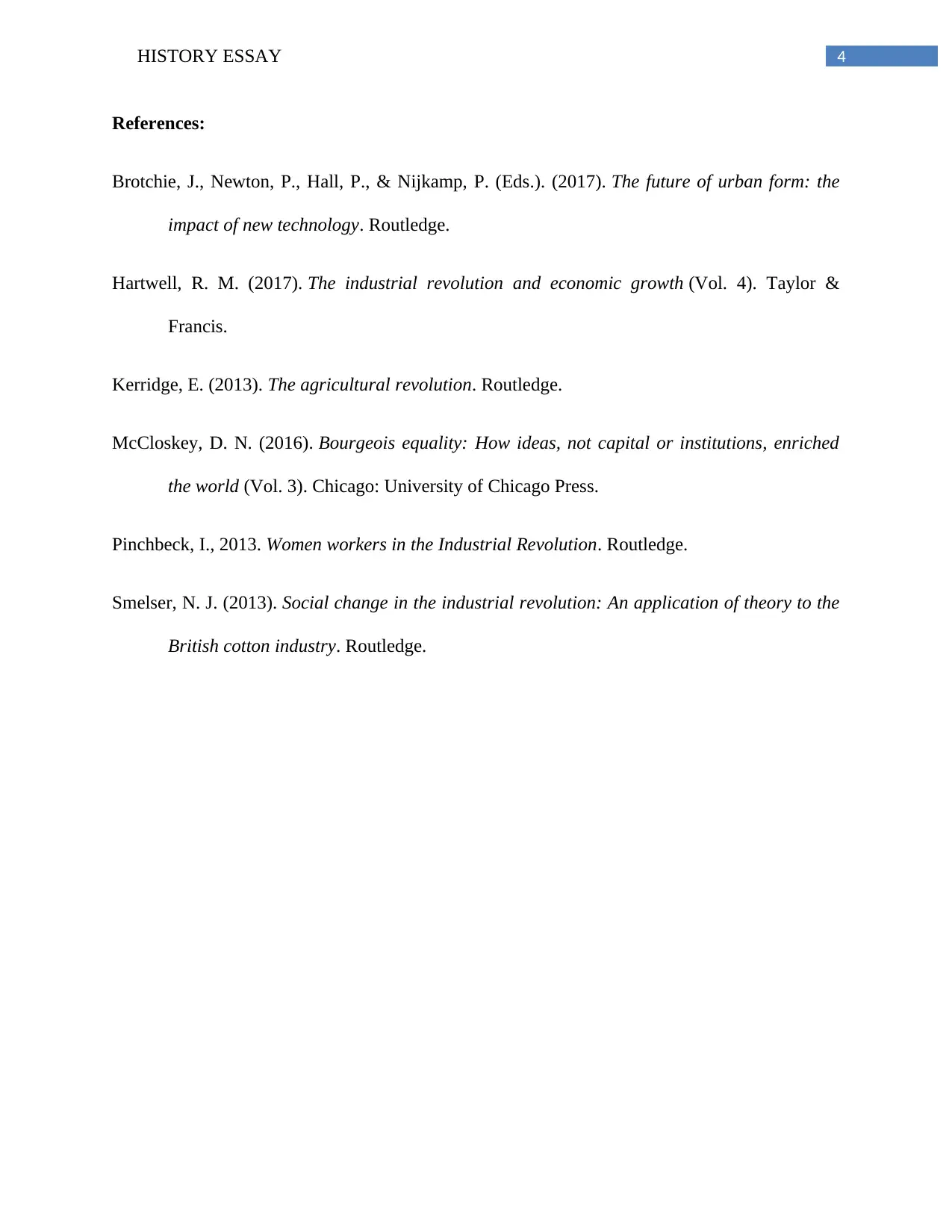
4HISTORY ESSAY
References:
Brotchie, J., Newton, P., Hall, P., & Nijkamp, P. (Eds.). (2017). The future of urban form: the
impact of new technology. Routledge.
Hartwell, R. M. (2017). The industrial revolution and economic growth (Vol. 4). Taylor &
Francis.
Kerridge, E. (2013). The agricultural revolution. Routledge.
McCloskey, D. N. (2016). Bourgeois equality: How ideas, not capital or institutions, enriched
the world (Vol. 3). Chicago: University of Chicago Press.
Pinchbeck, I., 2013. Women workers in the Industrial Revolution. Routledge.
Smelser, N. J. (2013). Social change in the industrial revolution: An application of theory to the
British cotton industry. Routledge.
References:
Brotchie, J., Newton, P., Hall, P., & Nijkamp, P. (Eds.). (2017). The future of urban form: the
impact of new technology. Routledge.
Hartwell, R. M. (2017). The industrial revolution and economic growth (Vol. 4). Taylor &
Francis.
Kerridge, E. (2013). The agricultural revolution. Routledge.
McCloskey, D. N. (2016). Bourgeois equality: How ideas, not capital or institutions, enriched
the world (Vol. 3). Chicago: University of Chicago Press.
Pinchbeck, I., 2013. Women workers in the Industrial Revolution. Routledge.
Smelser, N. J. (2013). Social change in the industrial revolution: An application of theory to the
British cotton industry. Routledge.
1 out of 5
Related Documents
Your All-in-One AI-Powered Toolkit for Academic Success.
+13062052269
info@desklib.com
Available 24*7 on WhatsApp / Email
![[object Object]](/_next/static/media/star-bottom.7253800d.svg)
Unlock your academic potential
Copyright © 2020–2025 A2Z Services. All Rights Reserved. Developed and managed by ZUCOL.




